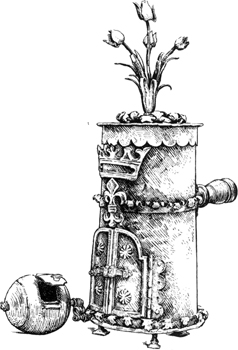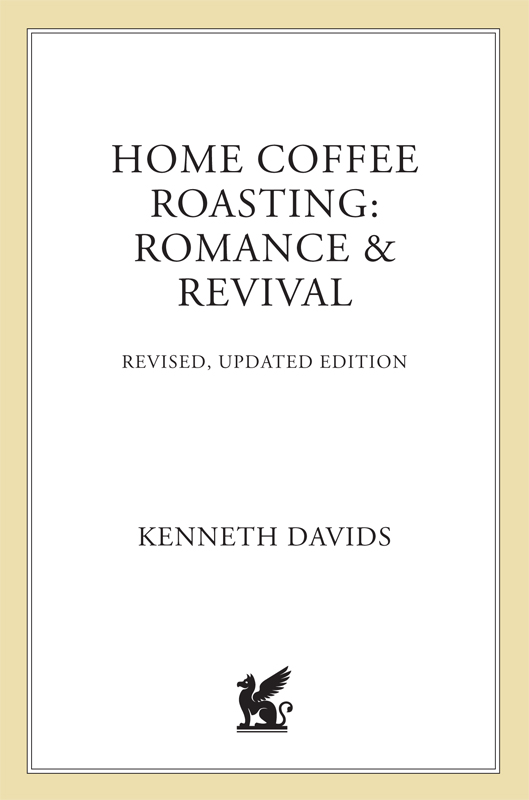
The author and publisher have provided this e-book to you for your personal use only. You may not make this e-book publicly available in any way. Copyright infringement is against the law. If you believe the copy of this e-book you are reading infringes on the authors copyright, please notify the publisher at: us.macmillanusa.com/piracy.
CONTENTS
IMPATIENT?
To begin roasting immediately, turn to the .
Chapter 1
WHY HOME ROASTING?
Authenticity, Economy, Alchemy
When I produced the first edition of this book in 1996, roasting coffee at home was an obscure activity practiced by amiably caffeinated hobbyists who often lavished tremendous homespun ingenuity in figuring out how to get their beans properly brown.
Today, homeor, as some would have it, alternative roasting is still obscure, but obscure on a much more substantial scale. No longer do home roasters need to assemble their own roasting apparatus or push beans around in an iron skillet. A dozen or more sleek new home-roasting devices have either nudged their way onto the market or are on the verge of nudging. Nor do alternative roasters need to satisfy themselves with lonely conversations with roasting beans, although some of us, doubtless, will want to continue that practice for therapeutic reasons. We now have the company of scores of Web sites and chat rooms devoted exclusively to our passion.
Nevertheless, home coffee roasting remains an oddball passion of the few, a practice that invariably provokes curiosity and long explanations.
Given its simplicityonce you know what youre doing, basic home coffee roasting ranks in difficulty somewhere between boiling an egg and making a good white saucewhy dont more people do it? Why isnt home coffee roasting already as popular as home baking, for example, or home pasta making or, for that matter, home corn popping?
First, most people simply dont know how vibrant truly fresh coffee tastes when compared to the partly stale version we usually drink. Almost everyone knows how exquisite fresh bread is or how much better home-popped popcorn is than the chewy, rubbery stuff that comes in bags. But the fragrance of coffee one day out of the roaster is a virtually forgotten pleasure.
Second, people dont know that roasting coffee at home is easy and fun, and something that everyone did before the victory of advertising and convenience foods.
Lettuce Comes from the Store
I once worked as a counselor in a day camp. One day while on a nature hike I invited the children to take bites of an edible weed Californians call miners lettuce. Several refused, on the basis that the leaves came out of the dirt and bugs had crawled on them. When I pointed out that they all ate lettuce, and that lettuce also came out of the dirt and risked having bugs crawl on it, one child objected. Lettuce doesnt come from the dirt, she declared. Lettuce comes from the store!
By the mid-twentieth century, Americans thought of coffee as granulated brown stuff that came from a can rather than the dried seeds of a tree requiring only a few relatively simple procedures to transform it into a beverage. As happened in the twentieth century with so many other foods and manufacturers, the actual facts about coffees origin (it consists of vegetable matter that has been dried, roasted, and ground by human beings) were replaced by market-driven substitute facts (coffee is brown granules produced by the complex machinery of an all-knowing corporation).
Of course, at the very moment of victory for brand-name convenience foods (say about 1960), some of the individuals who had recently come to be called consumers began turning themselves back into cooks or wine makers or brewers or bakers, setting off a countermovement. In the world of coffee the return to more authentic foods took the form of the specialty-coffee movement, which advocated a revival of the nineteenth-century practice of selling freshly roasted coffee beans in bulk and encouraged coffee lovers to take their beans home and grind them themselves. It is unusual in America today to find anyone interested in eating and drinking well who doesnt buy coffee in bulk as whole beans and grind the beans themselves before brewing.
There is no doubt that whole-bean coffees handled well are a tremendous advance in flavor and variety over supermarket packaged blends, and certainly anyone not yet introduced to the adventure of fine coffee should start by simply buying whole-bean coffee at the local specialty-coffee store, learning to grind and brew it properly, and experiencing some of the variety and pleasures it affords.
However, for the committed coffee aficionado, home coffee roasting is a logical next step toward closer intimacy with the bean and a mastery of ones own pleasure.

An elaborate Italian home roaster from the seventeenth century. It probably doubled as a heat stove. A charcoal fire burned inside the double doors at the bottom of the device. When someonedoubtless a servantwanted to roast coffee, the top lid with its elaborate tulip sculpture would be removed and replaced by the round roasting chamber with a crank pictured on the floor in front.
Nostalgia, Balconies, and Roasting Smoke
Throughout most of coffee history people toasted their own beans. Even in the United States, the cradle of convenience, preroasted coffee did not catch on until the latter years of the nineteenth century. Home roasting persisted in Mediterranean countries like Italy until well after World War II, and many coffee drinkers in the Middle East and the horn of Africa still roast their own coffee as part of a leisurely ritual combining roasting, brewing, and drinking in one long sitting.
Museum collections are full of wonderful old home coffee-roasting devices. One of the options you could buy with your fashionable new wood stove in nineteenth-century America was a home coffee roaster, usually in the form of a hollow cast-iron globe that fit inside one of the burner openings.
For people in countries where home roasting was the norm through the first half of the twentieth century, the practice is rich with nostalgia. Listen to Eduardo De Filippo, for example, a well-known Italian writer and performer, recollecting coffee roasting in his childhood Naples in Mariarosa Schiaffinos Le Ore del Caffe:
In 1908 in the streets and alleys of Naples, in the first hours of the morning, a very special ritual was celebrated, a ritual indispensable to less wealthy families as well as to better-off aficionados: the ceremony of coffee roasting. It saved money to buy raw coffee beans and then roast them at home, the only cost being personal skillfulness and patience. Every week (or every couple of weeks) a quantity of coffee was roasted, depending on the needs, finances, and appetites of each family.
And since these rituals were not simultaneous, every day somewhere in the neighborhood a woman or grandpa could be found sitting on the family balcony, turning the crank of the abbrustulaturo, or coffee roaster.
We now need to describe this object, today only a memory for most Neapolitans. It was a metal cylinder of thirty to sixty centimeters in length, with a diameter of about fifteen (twelve to twenty-four inches by six inches). Protruding from one end of the cylinder was a long pin; from the other a crank. Raw coffee beans were placed inside the cylinder through a small door in its side, which was firmly held closed by a little hook. The lower part of the device consisted of a rectangular steel box; inside the box a small charcoal fire was lit. At the top of either end of the box were grooves into which the pin and the crank fit, supporting the cylinder between them over the fire. Once the cylinder was placed atop the box the roasting could begin.







